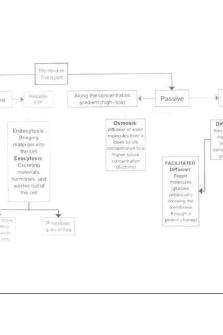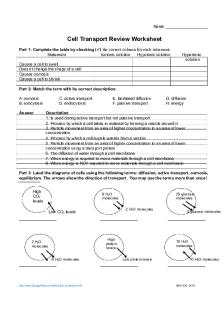Cell Transport Chart KEY Nov 2 copy brown PDF

| Title | Cell Transport Chart KEY Nov 2 copy brown |
|---|---|
| Author | Tiffany Gallina |
| Course | Biology |
| Institution | Georgia State University |
| Pages | 3 |
| File Size | 264.8 KB |
| File Type | |
| Total Downloads | 18 |
| Total Views | 134 |
Summary
summary info pics key for handout and explanation...
Description
Active and Passive Transport Chart
November 2020
Use the Passive and Active Transport PPTs we discussed in class to fill out the two tables below: Type of Transport
gradient?
Type of Concentration (High Low or Low High?)
Active or Passive Transport ?
NO
WITH
HIGH LOW
PASSIVE
NO
WITH
HIGH LOW
PASSIVE
WITH
HIGH LOW
PASSIVE
YES
AGAINST
LOW HIGH
ACTIVE
YES
AGAINST
LOW HIGH
ACTIVE
YES
AGAINST
LOW HIGH
ACTIVE
Uses Energy?
Goes with or against concentration
Diffusion
Osmosis
Facilitated Diffusion
Sodium Potassium Pumps
NO (but uses transport proteins)
Endocytosis
Exocytosis
Picture of Process?
Active and Passive Transport Chart Type Hypertonic
Description of process The solution has a higher concentration of solutes and a lower concentration of water than inside the cell. (High solute; Low water)
November 2020 What happens to cell? Water moves from inside the cell to the solution; Cell shrinks!
So, if there was a 10% salt solution inside the cell and 20% outside the cell, the water would want to move outside of the cell to try and help the outside reach equilibrium (get = to 10%)
Isotonic
The concentration of solutes in the solution is equal to the concentration of solutes inside the cell.
The cell would stay the same size
So, if there was a 10% salt solution inside the cell, there would also be 10% outside of the cell and water would flow equally into and out of cell.
Hypotonic
The solution has a lower concentration of solutes and a higher concentration of water than inside the cell. (Low solute; High water) So, if there was a 20% salt solution inside the cell and 10% outside the cell, the water would want to move INTO the cell to try and help the cell reach equilibrium (get = to 10%)
Water moves from the solution to inside the cell; Cell Swells and bursts open!
Picture
Active and Passive Transport Chart
November 2020...
Similar Free PDFs

Cell Organelle Chart Key
- 3 Pages

4- Cell Transport Review
- 4 Pages

Cell Transport Review Worksheets
- 8 Pages

Membrane Transport Flow Chart
- 1 Pages

Cell Transport Activity
- 3 Pages

Cell Transport Lab Report
- 2 Pages

Carrier-Chart - Copy - charts
- 2 Pages
Popular Institutions
- Tinajero National High School - Annex
- Politeknik Caltex Riau
- Yokohama City University
- SGT University
- University of Al-Qadisiyah
- Divine Word College of Vigan
- Techniek College Rotterdam
- Universidade de Santiago
- Universiti Teknologi MARA Cawangan Johor Kampus Pasir Gudang
- Poltekkes Kemenkes Yogyakarta
- Baguio City National High School
- Colegio san marcos
- preparatoria uno
- Centro de Bachillerato Tecnológico Industrial y de Servicios No. 107
- Dalian Maritime University
- Quang Trung Secondary School
- Colegio Tecnológico en Informática
- Corporación Regional de Educación Superior
- Grupo CEDVA
- Dar Al Uloom University
- Centro de Estudios Preuniversitarios de la Universidad Nacional de Ingeniería
- 上智大学
- Aakash International School, Nuna Majara
- San Felipe Neri Catholic School
- Kang Chiao International School - New Taipei City
- Misamis Occidental National High School
- Institución Educativa Escuela Normal Juan Ladrilleros
- Kolehiyo ng Pantukan
- Batanes State College
- Instituto Continental
- Sekolah Menengah Kejuruan Kesehatan Kaltara (Tarakan)
- Colegio de La Inmaculada Concepcion - Cebu








